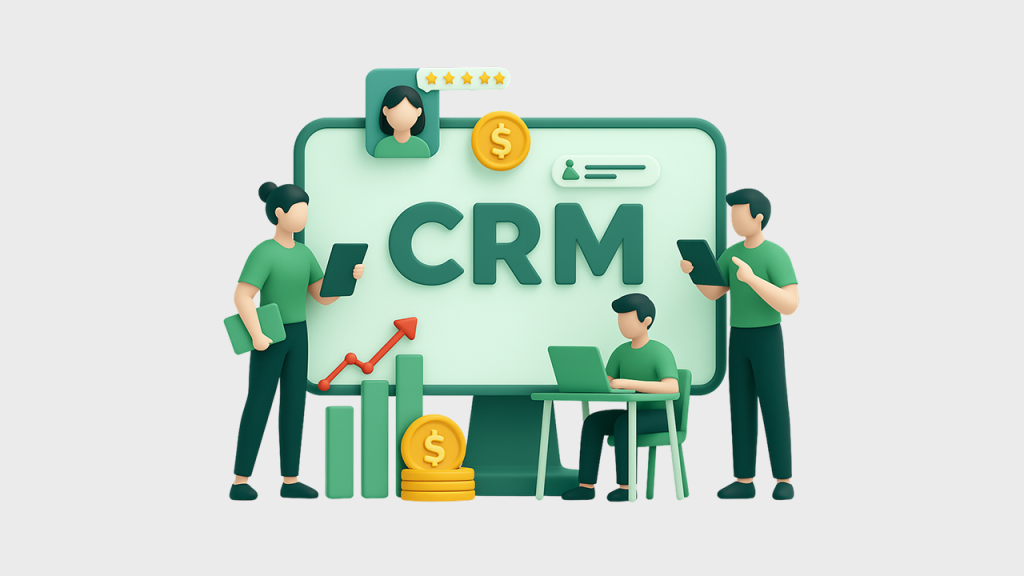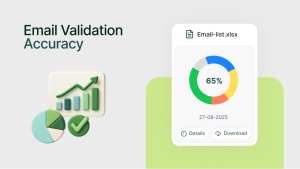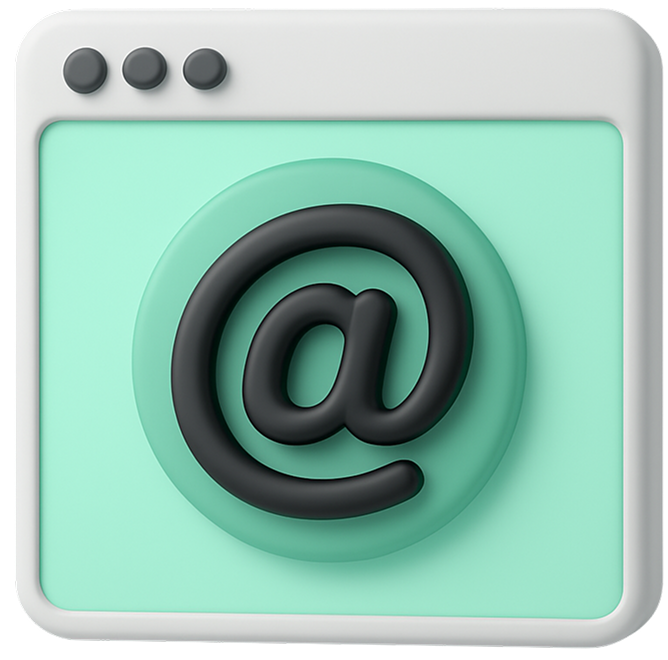Email marketing is a cornerstone of digital marketing success. But generic email blasts have little impact in crowded inboxes today. Savvy marketers are supercharging results by integrating CRM intelligence into their email strategy.

What is CRM?
CRM (Customer Relationship Management) is a technology for managing all your company’s relationships and interactions with customers and potential customers. A CRM system helps businesses store customer information, track customer history, manage communications, identify sales opportunities, and analyze data to improve customer relationships. The goal of CRM is to improve business relationships to grow sales, retain more customers, and increase profitability. CRM software, cloud platforms, and mobile apps allow businesses to consolidate customer data from all channels such as email, phone, social media, and the company website. This provides a unified view of each customer so businesses can deliver consistent and personalized messages and experiences across all touchpoints. With features like contact management, opportunity tracking, workflow automation, and analytics, a CRM boosts sales productivity and marketing effectiveness to drive revenue growth.
Integrating your CRM and email marketing platform takes some upfront work but delivers major benefits. Start by identifying valuable customer data in your CRM that can personalize and segment emails, like contact info, demographics, purchase history, interests, and support cases. Build workflows to securely transfer this data into your email service provider to populate detailed subscriber profiles. Use email plugins and API integrations to connect the two systems for seamless data flows. Import key campaign metrics from your email platform back to your CRM so nothing falls through the cracks. Leverage built-in CRM automation to trigger emails based on certain customer actions. Keep subscriber lists clean by automatically syncing opt-outs and unsubscribes from email to the CRM in real-time. Use integrated reporting to get a big picture view of multi-channel campaign performance. Align teams with workflows for effective handoffs of sales-ready leads from email to the CRM. With some strategic integration, you can optimize the entire customer lifecycle across robust CRM data and email marketing execution.
Reasons to Integrate CRM with Email
Read on to discover 10 ways this dream-team combination amplifies email productivity and performance.
#1: Build In-Depth Subscriber Profiles
Generic email lists only provide basic demographics like name, email, and location. Integrating CRM data compiles extensive profiles with purchase history, interests, support cases, content downloads, and more.
These 360-degree subscriber insights allow ultra-targeted segmentation and personalized messaging that truly resonates.
#2: Make Every Email Dynamic
Leverage CRM profiles to tailor content with personalized subject lines, images, copy, offers, and calls to action. This custom-fit messaging feels like it was written just for each recipient, driving higher open and click rates.
#3: Micro-Segment Your Lists
Granular segmentation is proven to boost engagement. CRM integration enables advanced segmentation by data points like customer type, lifecycle stage, recency, order history, and interests.
Micro-targeting emails generate far higher returns than broad blasts.
#4: Focus on Your Best Opportunities
CRM scoring models reveal your most valuable leads. Prioritize these high-potential contacts with tailored messaging and sales alignment to accelerate conversions.
#5: Act on Real-Time Behaviors
Behaviour triggered emails have outstanding response rates. CRM hooks detect actions like site visits, downloads, and cart abandonment, then deploy automated follow-ups to remarket at the moment.
#6: Delight with Cross-Channel Consistency
Tying systems together creates seamless customer journeys across channels. CRM continuity strengthens brand experience as prospects flow between email, web, social media, and sales.
#7: Optimize Send Timing
See when customers open, click and convert most in CRM reports to determine optimal send times. Schedule emails around these habits to maximize impact.
#8: Automate Manual Tasks
CRM eliminates tedious email chores like list cleaning, lead scoring, and sales team handoffs. Work smarter as critical functions happen automatically.
#9: Unlock Unified Reporting
Together, CRM and email provide complete multi-channel analytics to pinpoint what’s moving the revenue needle. This guides data-driven decision making.
#10: Grow Relevance and Results
Unifying CRM and email around the customer accelerates performance. Join the savvy marketers using this winning combination to engage audiences and drive sales more efficiently.
Integrating your CRM and email platform links messaging to how customers actually interact across channels – the key to captivating audiences.
Here is How CRM Transforms Email Marketing
A CRM-charged approach also amplifies the impact of your email marketing efforts. By integrating customer intelligence into your email campaigns, you can increase relevancy, optimize timing, prioritize outreach, and streamline cross-channel interactions.
Centralizing data on customer loyalty, purchase history, interests, and satisfaction enables you to create personalized email templates and promotional messages tailored to each subscriber’s needs. Email tools connected to the CRM help design and test targeted email marketing campaigns for different micro-segments of your audience based on their profiles and past interactions.
Ensure your emails are properly formatted and rendered across major email clients like Gmail, Outlook, Yahoo, and others by using CRM data to preview and test message display. Sync opt-outs and unsubscribe request back to the CRM in real-time to keep email lists clean.
Automate workflows for behavior-triggered emails to boost real-time customer retention when high-value actions are detected in the CRM, such as downloads, site activity, or case creation. Score leads based on the potential value to prioritize promotional outreach to those most likely to convert.
Drive ROI Through Strategic CRM-Email Alignment
With CRM-charged email marketing, you get the big-picture view of multi-channel campaign performance and customer journeys. Increased relevance, better timing, and cross-channel consistency enabled by CRM-email integration will captivate audiences and maximize your conversions.
However realizing these benefits requires an effective integration strategy. Start by auditing the valuable customer data in your CRM and mapping it to email use cases for segmentation, personalization, and automation. Identify any data gaps in your email platform that need to be filled. Evaluate potential connectors or APIs to sync data between the two systems.
Develop a phased rollout plan, focusing first on foundational integrations like contact syncing, lead scoring, and campaign linking between CRM and email. Test and refine data flows to ensure accuracy. Expand to more advanced functionality over time like behavior-based triggers, dynamic content, and cross-channel reporting.
Tightly align your teams across CRM, marketing, sales and customer service to take full advantage of the capabilities. Provide training and resources to help teams make the most of the integration. Measure email engagement, conversion, and revenue impact at every stage to demonstrate ROI.
A CRM-powered email approach can strengthen your overall sales process. Transactional emails and newsletters become more relevant when integrated with customer data. This increases satisfaction through personalized interactions that convert at higher rates.
However, quality content and verified data remain crucial for deliverability. Spam filters penalize irrelevant or untargeted messages. Leverage CRM profiles to create email content aligned to subscriber needs and interests.
Keep data flows clean to avoid issues with invalid or outdated contacts. Monitor campaign metrics like open rates, clickthroughs and conversions to refine your approach for continuous improvement.
With CRM and email tightly integrated around the customer experience, you maximize the benefits of personalized email marketing. Targeted outreach, meaningful messaging, and automation increase relevancy across the sales process. Ultimately this means more satisfied customers and higher ROI from your email efforts.
The payoff of planning and integrating your CRM and email systems is a better connection with audiences. Use these tips to develop an effective strategy that unlocks the full potential of CRM-powered email to drive your business growth.
Gamalogic: Powering Seamless CRM-Email Integration
Gamalogic provides the tools to seamlessly connect your customer data and email marketing. Gamalogic’s integration options allow syncing key data points from your CRM into your email service provider.
This powers personalized and segmented email campaigns while keeping CRM contact records updated in real time. Gamalogic also offers email verification services to keep lists clean and optimized for deliverability.
Their two-way data sync scrubs invalid or undeliverable emails from your CRM based on email campaign feedback. Gamalogic’s suite of CRM connectors, APIs, and verification services equip you to implement a tightly integrated CRM-email ecosystem.
You might also like

Email Validation Accuracy: Metrics, Benchmarks & How Providers Compare
Discover how to measure and improve email validation accuracy. This guide compares benchmarks, metrics, and top providers — helping marketers achieve <2% bounce rates and stronger deliverability.

Cold Email Isn’t the Same Game Anymore
Cold email isn’t what it used to be. Discover why old outreach tactics no longer work and learn how to adapt your cold email strategy for today’s inbox.

5 Must-Have Tools for Email Marketing Mastery
Want to take your email marketing to the next level? Discover 5 essential tools that streamline your workflow, boost deliverability, and drive better results—whether you're building campaigns or optimizing performance.






 No credit card required
No credit card required


Post your Comment.